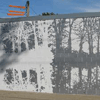 |
||||||||||||||||||||||||||||||||||
 |
||||||||||||||||||||||||||||||||||
| Bromides / Painting & Multimedia |
|
arctic maps
Books
|
 |
 |
 |
||
 |
 |
 |
 |
|
Statement
This body of work is all based upon a single photograph by Fox Talbot, the inventor of the silver negative photographic process.
In my Bromides series I have created versions of Talbot’s Reflected Trees in oil paint, watercolor and silver leaf. On the one hand, working from this photograph is a critique of the supposedly expressive nature of a landscape painting. However, I am more interested in the double inversion that happens here. Talbot's photos themselves attempted to mimic the "painterly" styles of his day, and are thus strongly picturesque and romantic. This ensured that they were more likely to be treated as "art."
In a sense, I am appropriating an appropriation, much as the silver negative process makes a picture from a picture. I am interested in the series of doublings that happen in these images: the trees in the initial scene are doubled in their reflection, which is then doubled in the negative, which is in turn doubled in the print, and finally doubled in my images.
Also, by transforming this photograph into paintings and drawings, I interrogate this idea of making an image more "art-like" by changing the medium of its depiction. Are hand painted images in any way more powerful than photographs? Does reproduction, mechanical or otherwise, affect the reception of an image?
| Click
image to enlarge, then click right and left to scroll |
| PORTFOLIO / EVENTS / ABOUT / Exhibitions / Press / NEWS / ARTS
WRITING / MUSIC / THEATER / CONTACT RICHARD BARLOW ©2010 / DESIGN FOR THE ARTS |